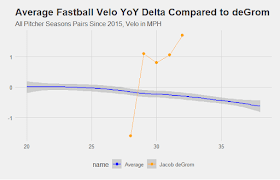How has he managed to be so consistent across multiple seasons? Major league hitters are obviously the best at what they do. In order to be so dominant, a pitcher like deGrom has to constantly be evolving. Whether it be by adding or tinkering with a pitch or altering your pitch mix, pitchers have to overcome the opposition's adjustments as they age. In conjunction with the league gaining familiarity on a certain pitcher, that pitcher also often combats the loss of velocity with age. Velocity is the ultimate equalizer in the world of pitching; it allows pitchers to get away with pitches right over the heart of the plate and can also make a fastball a viable two strike offering to put away batters. Most of the best pitchers in MLB have above-average to elite velocity and deGrom is no different. Even still, deGrom's velocity for a starter is highly unusual.
deGrom has continued to add velocity as he has aged. In this shortened season, his average fastball checks in at about 98.5 MPH better than all pitchers who have faced 200 batters this season, save for Dustin May and his super sinker. When you account for his age, what deGrom's velocity for a starter is unparalleled. May is 22 years old, while deGrom is 32. Of the top 20 starters in average fastball velocity (minimum 200 batters faced) only five are above the age of 30. Velocity is an attribute that pitchers start to lose basically the moment they enter the league. The following represent the average year over year changes velocity by age bucket and the aging curve for fastball velocities:
The first chart in the pair represents the average change in fastball velocity based on age year over year. The age on the x axis corresponds to the age in a given season. So, for example, age 25 indicates the change in velocity from age 24 to 25. The age averages were calculated using a weighted average of all pitchers in the age bucket. The weights are the total batters faced for each pitcher. The second chart shows the aging curve, where 0 represents the maximum fastball velocity and anything less than that is the velocity in the age bucket relative to that maximum. As I alluded to before, pitcher velocity peaks early and is in decline basically the moment that pitcher steps foot on a major league mound. Recall the chart with deGrom's average fastball velocity readings. deGrom, coming into the league at 26, has added velocity in each of the past five seasons (Statcast data goes back to 2015). For context of how unusual this is, here are the same charts of the league aging patterns versus deGrom:
I cannot emphasize enough how amazing this is. deGrom is taking everything we understand about pitcher aging and literally flipping it upside-down. By continuing to add velocity at this point in his career, deGrom is ensuring his viability as an ace. Even if his velocity ticks down over the next few seasons, he will still be among the leaders for starting pitchers. If his fastball still plays up, his main secondary offerings in his slider and changeup will continue to rack up swings and misses. Whether or not he wins another Cy Young award, watching deGrom dominate in a unique way well into his 30s will be one of the most fun stories to watch for the rest of the decade.







No comments:
Post a Comment